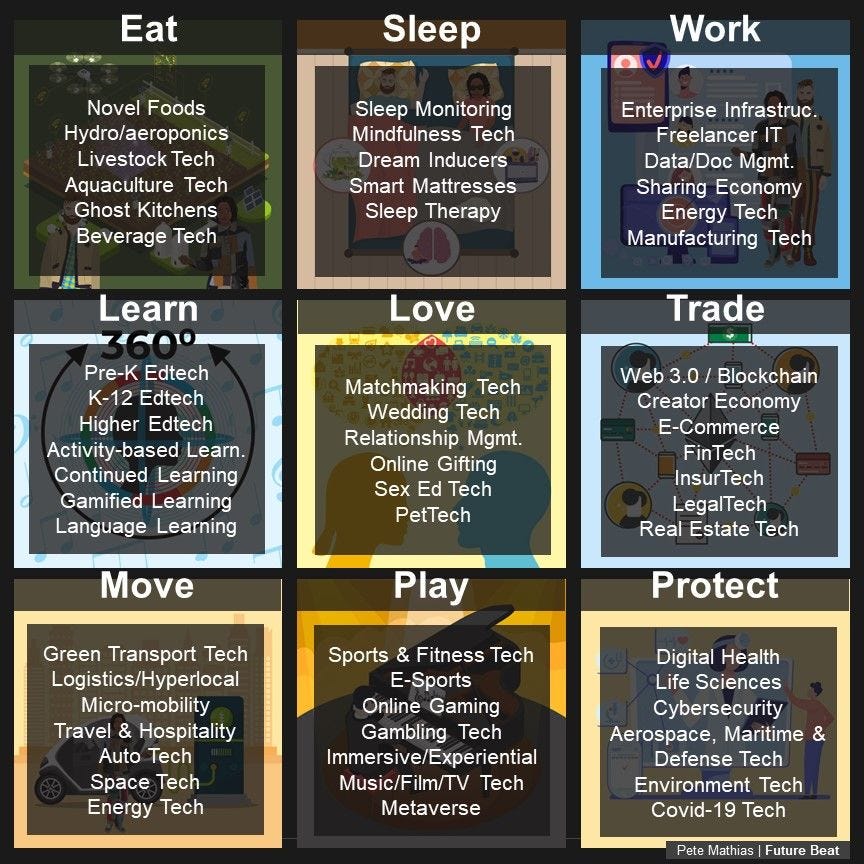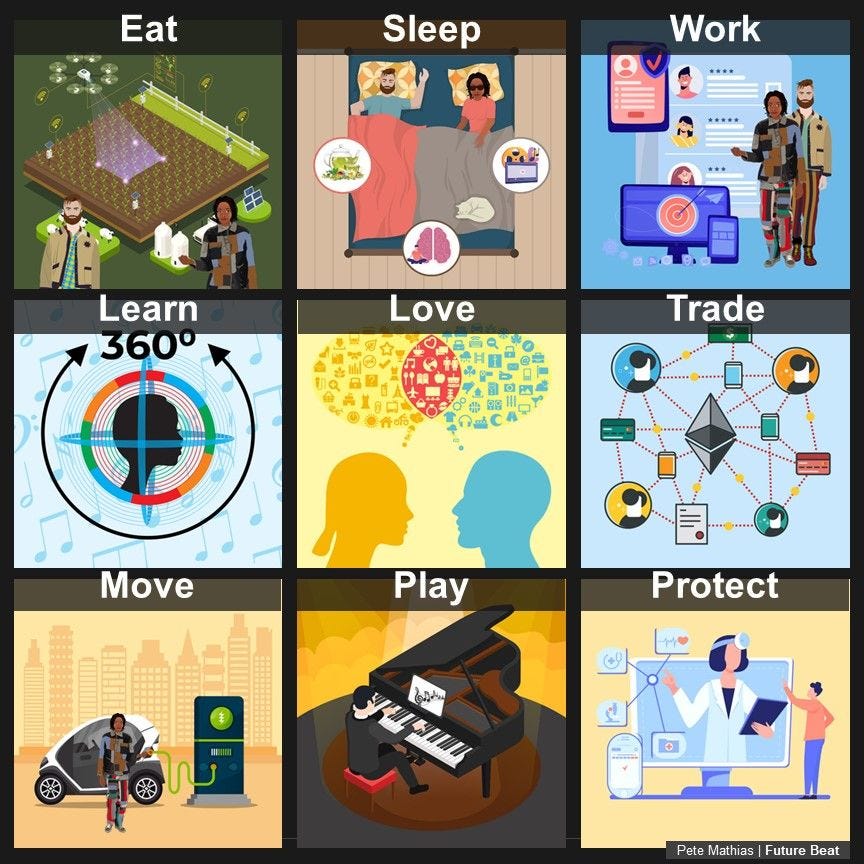Want the pulse on posterity? You’ve found your groove: Welcome to Future Beat.
Hi everyone 🥁!
This week I’m going deep on one of the biggest words (markets) out there: health.
What I am about to say may puzzle you, or may resonate a bit:
I believe the future of healthcare is entertainment.
If comparing doctors to rockers, scrubs to skinny jeans, or the $4T+ U.S. healthcare market to the ~$300B entertainment market seems narrow, naive, even nonsense—I get it. 🤔✅
But I believe healthcare’s future will be led by companies with entertainment-like competencies: Engagement, Personalization, and Localization.
Before we start: as always, scroll to the bottom for Jobs at amazing startups building the future! If you or a friend is intrigued by any, shoot me a note. I might be able to help.
Now, let’s groove. 1, 2, 3 + ….🥁🎶
Meet the Tik-Doc
First, a quick warm up: Seen @DoctorMike on TikTok?
Doctor Mike, a board-certified family medical physician, has 1.3M fans on TikTok.
Mayo Clinic, with an education budget of ~$370 million gets about 50 million unique visitors per month.
The point: Doctor Mike, on a budget that must hover around $0, has a marketing efficiency 10,000,000X one of the top medical research facilities in the world. Let that sink in:
A TikTok influencer conveys medical information at 10^7 greater efficiency than the No. 1 "Best Hospital" nationwide as by U.S. News & World Report in its 2021-2022 "Best Hospitals" rankings
TikTok (5 years old) and Mayo Clinic (158 y.o.) are simply at different points of digital transformation: TikTok is the very frontier of AI/ML-powered consumer digital, with its #ForYou recommendation engines nailing Engagement, Personalization, and Localization. Mayo Clinic is the very back of the pack, a laggard, a Blockbuster in the early 2000s.
In entertainment, Blockbusters became obsolete because of their high fixed costs, low utilization, and inaccessibility to remote movie fans. P.S., the last Blockbuster still exists in Bend, Oregon, but it is barely hanging on.
Healthcare is a different story. There are A LOT of “Blockbusters of Healthcare” with the triumvirate of asset-heavy pain points: 1) high-fixed costs, 2) low-utilization, and 3) hard-to-get to from remote places. These pain points materialize in cost (~20% of U.S. GDP is spent on healthcare), or the so-called “crisis of healthcare spending.” For example, we see staggering facts like 44 states now spend more on Medicaid than K-12 education, 48 million people can’t afford prescriptions, and hospitals stays are on track to cost 3x the cost a of a new car by 2040.
Michael Porter says the “goal of healthcare delivery is to improve value”— that seems rather obvious. But what is nonobvious is how to deliver value. I believe the how of healthcare requires doing 3 things well: Engagement, Personalization, and Localization. Someone called this Pete’s “EPL” thesis, which I kind of like. 👀🤳 🏳
Engagement: From Waiting Room to Any Room
Healthcare has an engagement problem. Americans only visit the doctor on average 4 times per year. Why such bad engagement? I think it is four “I” s: Traditional care is:
Inconvenient: for routine (e.g. “optional”) care, healthcare is inconvenient for hundreds of reasons (a 9 to 5, special needs, being immobile, too sick, lazy, etc.)
Impersonal: doctors are so over-utilized and burdened in paperwork (which can consume 50% of their day) they spend far less time with patients (~27% of day). An MD peer of mine in Health Tech Nerds captured the impersonal problem well: “Something we struggle with in traditional healthcare is connecting with patients (lots of barriers including EMRs, the pressure to see a higher volume of office visits, admin tasks).”
Impenetrable: HMOs, PPOs, EPOs, POSs, HDHPs, HSAs, Medicare, Medicaid—find me someone who can explain clearly all these because I don’t believe they exist. Why is it so easy to explain the intricate plots and infinite subplots of Game of Thrones or Ozark but impossible to explain the far more consequential and basic headlines of health insurance?
Inefficient: Many times “IRL” visits just don’t make sense. Even one B2B big pharma sales rep I talked to said that many of their “sales pitches” are increasingly happening via digital video, because it is just easier for clinics to review new products on demand. The same is true about a lot of analog hospital processes— digital is process optimization.
Healthcare innovators can learn a lot from a TikTok, Spotify, Netflix, or even a Reddit. “Entertainment-first” healthcare companies can transition from “the waiting room” to “every room,” from places we cringe/avoid into places we seek/smile.
Personalization: From Etch-a-Sketch to Wet Clay
What does an Etch-a-Sketch and a medical record have in common? We spend a lot of time to build up our picture, only for it all to be erased. I’m talking about the waiting room “can you fill out this form before the doctor sees you?”
The Etch-a-Sketch problem is actually a personalization problem. How is it that Spotify knows who we are— wherever we are—but a medical record doesn’t follow us around? Of course, there are many reasons for this. Healthcare is far from its own “Light FM” moment—far away from implementing a recommendation algorithm.
Healthcare is still in the Blockbuster era largely due to market-specific idiosyncrasies. As McKinsey explains, digital transformation of healthcare is laggard due to culture, mindset, organizational structure, governance and regulation. For example, regulation in the U.S. such as HIPAA protect individuals’ medical records or in the EU it is GDPR, which gives individuals the right to have organizations delete their data.
But it is also science: obviously, our biologies are far more complex and variant than our tastes for movies. How people react to drugs and therapeutics is not a “thumbs up” or “thumbs down,” but an infinite spectrum of outcomes.
Still, the companies that figure out personalization will lead the future. Winning in the digital health race will mean figuring out how to make, for example, the medical record not an Etch-a-Sketch but wet clay that continues to build through time into a Michelangelo renaissance masterpiece of true likeness.
Localization: From Microscope to Kaleidoscope
Healthcare is often treated as a microscope instead of a kaleidoscope— we expect if we zoom in we will see a static, crystal clear picture. But healthcare on a hyperlocal level is actually a kaleidoscope—zoom in, and we see ever changing fractals of variability: in no single place is healthcare a uniform object.
Here is a quick story: In 2018 I lived in China. One day when dining with a friend in Sanlitun of Beijing’s Chaoyang District, she told me about her bizarre doctor visit that day. She (an American) explained her surprise on two accounts:
First, when she arrived at the doctor, she did not sit in a waiting room. She stood in line. 🧍♂️🧍♂️🧍🧍🧍♀️🧍♂️🧍🧍♀️
Second, for her general check up, she didn’t see one doctor. She saw multiple doctors. Almost like a conveyor belt, she proceeded with other patients through a line as various professional inspected different aspects of her health: a doctor for her heart, a doctor for her ears, a doctor for her weight, etc etc. 🧑⚕️👨⚕️👩⚕️👨⚕️
Oh and did you know in Germany nurses wear white, not blue?
Healthcare delivery is wildly variable, deeply local. It is influenced by national and state regulatory frameworks, and preferences that are religious, social, economic, personal, and random too. An example: how we view vaccines in the U.S. ✝️🕌🕎 🕉🇺🇸🇨🇳🇻🇪 Further, there are the many socio-demographic variables impacting healthcare utilization. And of course, the power of the purse: just look at variance in healthcare expenditure per person globally (via WHO):
Content companies do localization really well. It is not just the fact that Netflix is offered in 62+ languages, it is the fact that every time anyone opens Netflix, it is a different view, different titles, even different thumbnails of the same titles, tailored to you. Netflix knows movie preferences are not static, consistent, or 1s or 0s. Neither is healthcare. Again: kaleidoscope, not microscope.
Healthcare can learn from these localization principles.
What Chance the Rapper teaches us about healthcare’s future
What does Chance have to do with the future of healthcare? Not much, except this:
When in 2017 Chance the Rapper—a hero in my sweet home Chicago—stood on stage at Staples Center to accept a GRAMMY for “Best New Artist” it was a historical moment. Never before had an artist won the industry’s most iconic award without ever releasing a physical album. Moreover, Chance released the record entirely on his own—hitting an astounding 1B SoundCloud streams without major label backing. And he proved that being “DIY” could eventually get the “seal of approval” of the institutions who vet music, i.e. The Recording Academy, which votes for The GRAMMYs (+full disclosure, I have been a Recording Academy Voting Member).
Seeing Doctor Mike, our TikTok “influencer MD,” and his 1.3M+ TikTok fans feels a little like Chance’s own moment. We are witnessing health entrepreneurs reimagine, recast, reinvigorate an otherwise ailing healthcare Blockbuster. Chance’s GRAMMY win sealed a trend into a truth: that the “music business” was no longer about distribution, it was about attention. Winning and retaining fans.
It is only a matter of time until the @DoctorMike’s win the approval of the Mayo Clinics.
There are already amazing health tech entrepreneurs rebuilding healthcare for its digital frontier. While of course one cannot equate or reduce the infinite complexity of healthcare to entertainment, there are important lessons to learn.
I do believe that there will be a day when we look back at the waiting-room clipboard the way we look back at CDs. Not only will we not want to write down our medical history on paper, but there probably won’t be any clipboards manufactured in the first place. Those that ditch the clipboard first, will be those that are good at what put CDs out of business: entertainment companies aware of the unrelenting power of Engagement, Personalization, and Localization.
Thanks for reading. These views are a work-in-progress. I have so much to learn, and look forward to hearing from you— especially the many experts who know far more than me about healthcare.
Future Beat gives periodic insights on “common words” and how they’re changing. To give you a sense of the kinds of words—and tech areas—I am curious about, I made this:
Are there other areas you’re interested in? I’d love to hear your interest areas—and especially your feedback / views!
Jobs! (sorted by “Word”)
want to build the future or have a friend who does? I carefully curate incredible openings at incredible startups… scroll to bottom!
Health. Ribbon Health (health data) has 44 openings
Health. Oula (personalized pregnancy) has 1 opening
Build. Oliver Space (room builder) has 20 openings
Learn. Hellosaurus (education) has 5 openings
Wear. Archive Resale (peer-to-peer resale) has 11 openings
Pay. Topi (digital payments) has 7 openings
Work. Gloat (future of work) has 129 openings
Work. One Schema (automation) has 3 openings
Don’t miss a beat—subscribe.
Rock on 🤘,
Pete
Oh, and PS…if you have any crypto friends: I’m heading to ETHDenver next week to moderate a music panel and explain why in 2013 my band listened to a Chicago Mercantile Exchange trader and opened a Bitcoin music store. HMU on Telegram @p3t3Math1as !
FUTURE BEAT
(views are Pete’s / only Pete’s)













Pete, I love how you are drawing parallels and contrast between those two industries! Pete's EPL thesis is also powerful (and memorable)!
I can't wait to read your insider future-gazing scoop on the Play vertical. How different is our Play time look in 5-10 years from now? Dying and emerging media formats? With your background in the space, this is a wisdom gem in making, you are gonna drop sooner or later. 👀 #eagerly